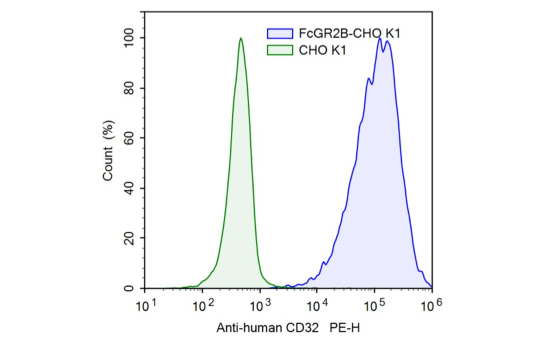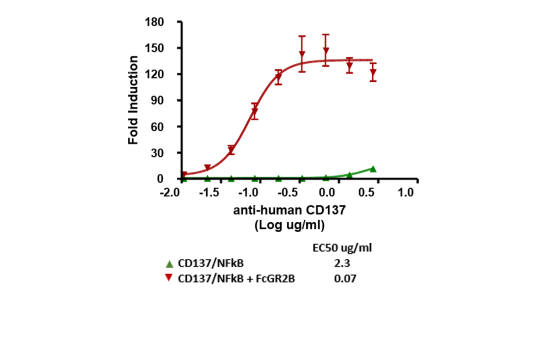FcGR2B CHO K1 Recombinant Cell Line
CHO-K1 cells stably expressing full-length human recombinant FcGR2B (Fc gamma receptor IIb, FcγRIIB). Cell surface expression of human FcGR2B (Genbank #NM_004001.4) was confirmed by flow cytometry.
Purchase of this cell line is for research purposes only; commercial use requires a separate license. View the full terms and conditions.
Media Required for Cell Culture
| Name | Ordering Information |
| Thaw Medium 3 | BPS Bioscience #60186 |
| Growth Medium 3D | BPS Bioscience #79539 |
Materials Required for Cellular Assay
| Name | Ordering Information |
| Thaw Medium 1 | BPS Bioscience #60187 |
| Assay Medium: Thaw Medium 3 | BPS Bioscience #60186 |
| CD137/NF-κB HEK293 cells | BPS Bioscience #79289 |
| Anti-CD137 recombinant human antibody | BPS Bioscience #79097 |
| ONE-Step™ Luciferase Assay System | BPS Bioscience #60690 |
| 96 well tissue culture treated white, clear-bottom plate Luminometer |
The cell line has been screened to confirm the absence of Mycoplasma species.
FcGR2B (also known as CD32B), is a receptor for the Fc region of immunoglobulin G (IgG) and is known as an immune antibody checkpoint.
The two major forms of FcGR2B, FcGR2B1 and FcGR2B2, arise from either the inclusion or exclusion (respectively) of exon C1 via mRNA splicing, resulting in differing cell type-specific expression and function. Presence of the C1 sequence in isoform 1, which is highly expressed at the surface of B cells, tethers the receptor at the membrane and dramatically increases its half-life at the cell surface. Absence of C1 in isoform 2, expressed in myeloid cells, triggers rapid internalization of the receptor upon ligand binding. FcGR2B induces the phagocytosis of aggregated immunoglobulins. The receptor is also expressed in airways and in liver endothelial cells, where it may act as a “sink” for the removal of IgG immune complexes.
FcGR2B1 operates as a negative regulator of signals induced by antibodies bound to antigens at the surface of cells. Although it acts in concert with dozens of activating receptors, it is the only known negative regulator of B Cell Receptor (BCR)-induced activation of B cells. Thus, the biological function of FcGR2B1 is to tame the antibody-dependent inflammatory response and to clear the circulation of spent immune complexes. Defects in FcGR2B1 signaling lead to overt inflammation and are involved in autoimmune diseases.
In addition, FcGR2B interferes with the efficacy of therapeutic antibodies as it accelerates antibody depletion and decreases B cell responses and antibody production. On the other hand, FcGR2B contributes to the anti-tumor response to antibody checkpoint therapy by boosting CD+ T cells through cross-linking of antibodies directed at stimulatory checkpoints expressed on immune cells such as 4-1BB, OX40, CD40 and GITR.
Therefore, FcGR2B is an important immunotherapy target, both as a direct target for the treatment of B-cell malignancies and in combination with clinically relevant therapeutic monoclonal antibodies to overcome FcGR2B -mediated resistance.



